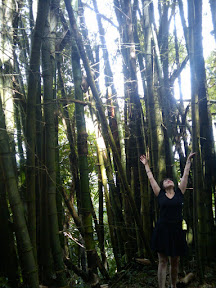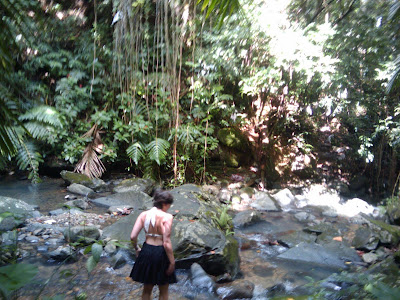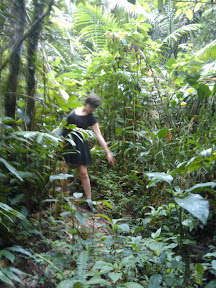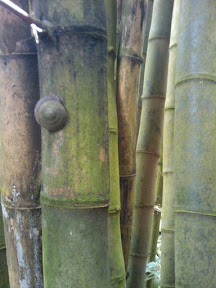
El Yunque
Covering some 28,000 acres of land in the Sierra de Luquillo, this verdant tropical rain forest — recently rebranded El Yunque National Forest — is a shadow of what it was before axe-wielding Spanish conquerers arrived in the 16th and 17th centuries.
...
Compared to other Puerto Rican forest reserves, El Yunque is well staffed and crisscrossed by an excellent network of signposted trails. But adventurers beware. In contrast to national parks in the mainland US, there's no true wilderness experience to be had here. Unlike North Americans, Puerto Ricans have never truly incorporated wilderness hiking in the national psyche. As a result, most of El Yunque's hikes are short, paved and relatively mild compared to the trails of Yellowstone and Yosemite. Crowds populate El Yunque's popular spots in peak season, but if you stray off the standard tourist routes, there are still plenty of places to slip under the radar.
...
La Coca TrailThis popular 1.8-mile hike will take you a little over an hour each way. The trailhead is just up the road past the falls of the same name – just before Yokahú Tower – and there is a small parking lot here. It's a fairly benign, low-altitude trail following streams through tobonuco forrest. La Coca made its mark on El Yunque history when a US college professor disappeared here for 12 days in 1997, claiming after his rescue that he got off the trail and was lost. The Forest Service, which had enlisted a search party) of 60 volunteers and aircraft, was hardly amused. If you follow La coca to its end, you can go left (east) along Carillo Trail to the eastern part of the forest or right (west) to La Mina Falls on La Mina Trail (below).
— Lonely Planet Puerto Rico
 Now, I've never been to Yosemite or Yellowstone, but I've been on quite a few hiking trails in Connecticut, Massachusetts and Vermont, and been camping a few times. I even once hiked down and up the Grand Canyon. I realize now how well-maintained these trails were, wide and relatively smooth and well marked. From the descriptions above, we expected "benign" La Coca trail to be like that except paved, and we wore regular walking shoes and brought a couple bottles of water and some tropical fruit we'd bought off of a farmer selling his products out of the back of a pick-up truck along the highway. The story about the professor lost for 12 days should've sent warning signals, I suppose, but the tone of the description is so dismissive (he "claimed" he lost the path, the Forest Service was "not amused" — imagine how the professor felt) that we didn't think anything of it. We arrived at about 2pm, driving up highway PR-191 into the mountains blanketed by El Yunque (pronounced "JOON-kay" in Puerto Rican Spanish). We figured we'd follow the path to the end, switch to the (easier and shorter) La Mina Trail, and the whole thing wouldn't take more than two hours. Matters were slightly complicated by the fact that according the map in the Lonely Planet, La Coca intersected the Big Tree Trail and not La Mina (which we couldn't find on the map at all), but Big Tree was also supposed to be very easy and ran parallel to La Mina. We'd be back in San Juan (over an hour drive away) in time to see the sunset on the beach. Little did we suspect the ordeal that was to follow.
Now, I've never been to Yosemite or Yellowstone, but I've been on quite a few hiking trails in Connecticut, Massachusetts and Vermont, and been camping a few times. I even once hiked down and up the Grand Canyon. I realize now how well-maintained these trails were, wide and relatively smooth and well marked. From the descriptions above, we expected "benign" La Coca trail to be like that except paved, and we wore regular walking shoes and brought a couple bottles of water and some tropical fruit we'd bought off of a farmer selling his products out of the back of a pick-up truck along the highway. The story about the professor lost for 12 days should've sent warning signals, I suppose, but the tone of the description is so dismissive (he "claimed" he lost the path, the Forest Service was "not amused" — imagine how the professor felt) that we didn't think anything of it. We arrived at about 2pm, driving up highway PR-191 into the mountains blanketed by El Yunque (pronounced "JOON-kay" in Puerto Rican Spanish). We figured we'd follow the path to the end, switch to the (easier and shorter) La Mina Trail, and the whole thing wouldn't take more than two hours. Matters were slightly complicated by the fact that according the map in the Lonely Planet, La Coca intersected the Big Tree Trail and not La Mina (which we couldn't find on the map at all), but Big Tree was also supposed to be very easy and ran parallel to La Mina. We'd be back in San Juan (over an hour drive away) in time to see the sunset on the beach. Little did we suspect the ordeal that was to follow.
The trailhead was barely marked, a little sign by the road that you could easily miss. But when we finally found it, my fiancée Marina and were excited to find it unpaved. An actual hike! We started down the path, noting in passing how steep and rugged it was, but not thinking much of it. We stopped to take pictures in front of a copse of bamboo. We struggled a little when we came to tree that had fallen, obscuring the path, as we climbed over its massive, upended roots. We noticed there were some ribbons tied to a few of the trees to mark the trail, but not with any consistent frequency and not consistently colored.
 Another fallen tree provided a convenient seat, swaying slightly under us, and we ate an orange by a babbling stream. When we finished, we looked around. Which way? A trail seemed to extend up the stream toward a waterfall and there was even a ribbon (though dirty and broken, barely clinging on) attached to one of the trees. I thought we'd already come to the end, to La Mina falls. But the terrain suddenly got much more difficult, and we had to push through overgrown brush and clamber over rocks. Finally we realized there was no longer a trail, the only path one we'd have to clear ourselves with a machete. We doubled back and carefully found our way back to the log. I suggested going farther the other way along the stream, or simply going back, but we had noticed what looked like a way up the steep slope on the other side of the water. Were we supposed to cross? There was no easy way to, and certainly no signage, but we carefully moved from rock to rock and when we had scaled the slope, we found what was definitely a continuation of the path. Onward!
Another fallen tree provided a convenient seat, swaying slightly under us, and we ate an orange by a babbling stream. When we finished, we looked around. Which way? A trail seemed to extend up the stream toward a waterfall and there was even a ribbon (though dirty and broken, barely clinging on) attached to one of the trees. I thought we'd already come to the end, to La Mina falls. But the terrain suddenly got much more difficult, and we had to push through overgrown brush and clamber over rocks. Finally we realized there was no longer a trail, the only path one we'd have to clear ourselves with a machete. We doubled back and carefully found our way back to the log. I suggested going farther the other way along the stream, or simply going back, but we had noticed what looked like a way up the steep slope on the other side of the water. Were we supposed to cross? There was no easy way to, and certainly no signage, but we carefully moved from rock to rock and when we had scaled the slope, we found what was definitely a continuation of the path. Onward!
 Here the trail really started to become treacherous. Thick mud sucked at our feet or slid away underneath us or fallen leaves hid slippery mud beneath. Jagged rocks stuck out at all angles and threated to twist our ankles with every step or slick and wet and mossy made us slip and slide across them. To make matters worse, the soupy humidity kept fogging over our glasses, so we had to keep stopping to clean them off. Every once and a while we'd come to a humble trail marker, a little post with a blue tile saying we were still on La Coca trail and how much farther to the trail head. The trail head! At this point we were desperate to find it and connect to the easier trail, to get out of the jungle.
Here the trail really started to become treacherous. Thick mud sucked at our feet or slid away underneath us or fallen leaves hid slippery mud beneath. Jagged rocks stuck out at all angles and threated to twist our ankles with every step or slick and wet and mossy made us slip and slide across them. To make matters worse, the soupy humidity kept fogging over our glasses, so we had to keep stopping to clean them off. Every once and a while we'd come to a humble trail marker, a little post with a blue tile saying we were still on La Coca trail and how much farther to the trail head. The trail head! At this point we were desperate to find it and connect to the easier trail, to get out of the jungle.
El Yunque rain forest, the only tropical rain forest in United States territory, is filled with a lush, diverse ecosystem of plants and animals. We did not see them. Oh, we saw plenty of plants, mostly lots and lots of trees and vines. As far as animals, we saw a few very small lizards (lagartijos, as the Puerto Ricans call them), many snails, and spiders in dozens of spider webs that we crashed through as we went, the hapless spiders crawling over our skin. We didn't see mosquitoes, but we definitely felt them nibbling at us. And that was about it. We heard bird songs, to be sure, but didn't see any at all. I joked that at least if we got lost in the jungle, we could live off of escargot tartare.
We came to another stream, this one more of a small river, and stood on a boulder trying to find some sign of a path. We spied a lonely trail marker on the other side of the water. I hopped across rocks in a careful balancing act almost slipping and falling a couple times and soaking one shoe with a misstep. Marina took off her sneakers and simply waded across. The trail began to go uphill, which was actually a relief to me because thus far it had been almost entirely downhill and uphill meant we might be heading back to the road. We carefully walked one foot in front of the other as the trail narrowed, hanging onto vines to keep from tumbling down the steep edge to our death. I had picked up a stick and was waving it in front of me to try and destroy spider webs as we went, but I was getting tired and I still ended up walking face first into several. It was clear no one had come this way in some time. Maybe not since the professor was lost. Large portions of the trail were completely untended and two more times we came across enormous felled trees that we not only had to climb over or around, but made it difficult to locate the trail on the other side.
 There were occasional bursts of rain, happing in the midst of sunlight and lasting no more than a few minutes. We'd brought a small umbrella (afternoon rains are common in Puerto Rico this time of year), but it wasn't necessary as the forest canopy blocked most of the water. Only a handful of drops made it through and landed on the chincy "Puerto Rico" panama hat I'd bought to keep off the sun.
There were occasional bursts of rain, happing in the midst of sunlight and lasting no more than a few minutes. We'd brought a small umbrella (afternoon rains are common in Puerto Rico this time of year), but it wasn't necessary as the forest canopy blocked most of the water. Only a handful of drops made it through and landed on the chincy "Puerto Rico" panama hat I'd bought to keep off the sun.
The trail sloped down once more and once again we were faced with a river, this time complete with rushing rapids. There was no way of getting across this one without getting your feet wet. We cast around looking for the trail, and finally found a marker just before the river that marked this as end of La Coca trail. But where was La Mina trail, or the supposedly magnificent La Minas Falls? Where was the Big Tree Trail? We couldn't find anything. Finally, betting on past experience, we forded the water. We found a spot fifty feet upriver where the rapids weren't as strong. My feet were completely wet from stepping in mud at this point, so while Marina once again took off her shoes, I said screw it and just waded through. The water came up to my knees. We scrambled up the far bank and over a steep cliff. Surely La Mina trail and easy going would be here! I came up first and found a green wooden gate across the only trail-like area in front of us.
"Is it a trail marker?" Marina called after me.
"It is, but you're not going to like it," I said.
The gate read, in Spanish and English, "Trail Closed."
It was now 4:30 pm. The night before we'd been kayaking in a bioluminescent lagoon in Fajardo and in the pitch darkness of night without any human lighting to obscure it, our hands had left beautiful glowing wakes as we drew them through the water. There we had had guides, plenty of company and little safety lights on our life-jackets. Here we didn't even have reception on our cell phones. Night time would mean we wouldn't be able to see our hands in front of our face, much less a poorly-marked trail ahead of us. And the only person who knew we were out here was the valet at our hotel, to whom we'd casually mentioned our plans.
 I suggested going up the closed trail anyway, but Marina vetoed that. If this was the condition of an open trail, a closed trail wasn't anything we wanted to contemplate. So we had to turn back.
I suggested going up the closed trail anyway, but Marina vetoed that. If this was the condition of an open trail, a closed trail wasn't anything we wanted to contemplate. So we had to turn back.
Once again we pushed our way across the river and after some searching managed to find the La Coca trail again. Back up and down we went, our pace more urgent. Rocks that we had carefully navigated one step at a time we now blew past. We slipped in the mud and fell. Our bodies ached, but it didn't matter, we had to get out of the jungle before nightfall or we weren't leaving the jungle.
After we got across the second river again, things became more serious. The route here was almost entirely uphill, much more arduous. We'd taken the last sip of our water, and we were sweaty and parched and exhausted. We continued to slip and fall in the mud. The light began to fade, a little at first, but then precipitously fast. Every time I sat to rest it was harder to get up again, and while the tiredness dragged at me, the panic seemed to energize Marina, who acted as a much-needed drill sergeant, forcing me up and onwards. After what seemed like forever, we made it back to the first stream. I nearly drank from it, I was so thirsty, but by the time I'd gotten across I was so happy to have made it I just kept going.
The final part of the trail was much, much steeper than I remembered. We almost went up the wrong way again; as dusk set in, it was almost impossible to see any details. By the time we reached the first felled tree, everything had become gray, and Puerto Rico's distinctive coqui frogs had begun their evening onomatopoeic song. A bat flew across our path. We could not for the life of us find the way and Marina was caught in the roots of the tree and had trouble getting out. Finally, I stumbled across the trail and waited for Marina to get herself free. I couldn't see her in the darkness, couldn't do anything but call out so she could find me by my voice. Again we started up. Fireflies began dotting the air in front of us. I fell in the mud and found myself unable to get up. My body hurt too much. I think I'd pulled a muscle or two. Maybe a night sleeping in the mud wouldn't be so bad. I could fall asleep, no problem. I would feel so much better in the morning. Marina was standing above me, saying something very sternly, but I couldn't hear her. I had started crying.
 She bent down, "You're scaring me," she said. She pulled me up and half carried me until I could manage on my own. By now we had our cell phones out and were using them as make-shift flashlights. Somehow we managed to stay on the trail. We cheered when we reached the copse of bamboo where we'd taken pictures at the beginning of our trek.
She bent down, "You're scaring me," she said. She pulled me up and half carried me until I could manage on my own. By now we had our cell phones out and were using them as make-shift flashlights. Somehow we managed to stay on the trail. We cheered when we reached the copse of bamboo where we'd taken pictures at the beginning of our trek.
By the time we finally pulled ourselves onto the asphalt of Route-191, praising the Tainu god Yokahú for delivering us safely from his wilderness, it was after 7 pm and dark as coal. We lay on the ground for a while, staring up at the stars. No cars went by. We were soaked and covered in mud.
"You know," I said, "I'm suddenly in favor of paving the rain forests."
We struggled back up to where we'd parked, maybe 300 feet up the road at Yokahú Tower, completely uphill but still the easiest 300 feet we'd ever walked. We were the only car left in the lot. I tried to pull off one of my shoes and had a horrendous muscle spasm in my right calf, and all I could think as I clutched my leg and screamed was thank God it hadn't happened in the jungle. There had been so many opportunities for us to have been seriously injured, to twist on ankle or get cut by sharp rocks or slip off down cliff-like inclines. We didn't have a first-aid kit, we didn't have a way too call for help, we didn't have anything. We simply weren't prepared.
Stupidly, I'd brought only one pair of pants with me on the trip to PR (I'd already ended up blow-drying them after kayaking the day before). Driving back, after getting several bottles of water at a local convenience store (fresh, deep well water from the heart of El Yunque Rain Forest), we stopped at a Wal-Mart, drawing plenty of stares as we limped around muddy and wet, and we bought some new clothes and candy.
And then we went back to the hotel, showered, changed, rested and then went back out for a late-night, obscenely expensive victory dinner at a fancy restaurant.
The moral of the story as far as I'm concerned: Don't always trust the guide book. And the jungle is not for humans.
